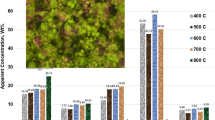Abstract
The depletion of good-quality phosphate resources, coupled by a need to supply acceptable products at a rapid rate, while meeting the specifications of fertilizer chemical plants, is of significant concern to the phosphate industry, particularly the production of concentrates with tolerable dolomite content. Tremendous efforts have been made in the past to develop an efficient and economical process that can effectively reject dolomite. However, dolomite removal continues to plague the phosphate industry due to several process-specific challenges being encountered with various beneficiation technologies. In this regard, detailed characterization of phosphate reserves is crucial to understand textural limitations and help design appropriate strategies to achieve quality products. In this paper, the development of procedures to establish dolomite rejection/francolite recovery curves for gravity preconcentration of pebble phosphate from Central Florida is described using high-speed X-ray computed tomography (HSXCT). The developed procedure is illustrated with the analysis of high MgO pebble phosphate samples (10.39 mm × 1 mm) received from South Pasture and Four Corners locations operated by the Mosaic company. The rejection/recovery curves were calculated for each sample for five different particle size classes to observe the trend in rejection/recovery with variation in particle size. In order to evaluate the reliability of the HSXCT data, analysis using the high-resolution X-ray computed tomography (HRXCT) technique was performed on one particular sample (FC-3-1). Finally, to assess the separation efficiency, the HSXCT and HRXCT rejection/recovery curves obtained were compared to experimental gravity preconcentration results reported in the literature. In this way, liberation limitations for gravity preconcentration in the processing of pebble phosphate have been established based on X-ray computed tomography analysis.


















Similar content being viewed by others
References
Baudet G, Save M (1999) Phosphoric esters as carbonate collectors in the flotation of sedimentary phosphate ores. Beneficiation of Phosphates: Advances in Research and Practice, P. Zhang, H. El-Shall, R. Wiegel, eds., SME, Littleton, CO, USA, pp 163-185
Baumann AN, Snow RE (1980) Processing techniques for separating MgO impurities from phosphate products. Proceedings of the 2 nd International Congress on Phosphorus Compounds, Paris, pp 269-280
Florida Industrial and Phosphate Research Institute (2018) The conventional phosphate beneficiation process. http://www.fipr.state.fl.us/about-us/phosphateprimer/phosphate-beneficiation/ (accessed 20 June 2018)
Gao Z, Zheng S, Gu Z (2002) Review of beneficiation technology for Florida high dolomite pebble. Beneficiation of Phosphates, Fundamentals and Technology, P. Zhang, H. El-Shall, P. Somasundaran, R. Stana, eds., SME, Littleton, CO, USA, pp 247-259
Gharabaghi M, Irannajad M, Noaparast M (2010) A review of the beneficiation of calcareous phosphate ores using organic acid leaching. Hydrometallurgy 103:96–107
Gu Z (2007) Dolomite flotation of high magnesium phosphate ores using fatty acid soap collectors. Ph.D. Thesis, West Virginia University, Morgantown, WV, USA, pp. 3-6
Gu Z, Gao Z, Zheng S (1999) Beneficiation of Florida dolomitic phosphate pebble with a fine-particle flotation process. Beneficiation of Phosphate: Advances in Research and Practice, P. Zhang, H. El-Shall, eds., SME, Littleton, CO, USA, pp 155-162
Hassan E, Bogan M (1994) Characterization of future Florida phosphate resources. Florida Institute of Phosphate Research, Final Report, FIPR Contract No. 89-02-082R, pp 10-17
Kawatra SK, Carlson JT (2013) Beneficiation of Phosphate Ore. SME, Englewood, CO, USA, pp 79–99
Lawver JE, Wiegel RL, Snow RE, Hwang CL (1978) Phosphate reserves enhancement by beneficiation. Min Cong J 68:27–31
Lawver JE, McClintock WO, Snow RE (1983) Method of beneficiating phosphate ores containing dolomite. US patent 4372843A
Lin CL, Miller JD, Herbst JA, Rajamani K (1987) Comparison of methods for the measurement of linear grade distributions in liberation analysis. Part Part Syst Charact 4:78–82
Miller JD, Lin CL, Ahmed I, Wang X, Zhang P (2012) Advanced instrumentation for mineral liberation analysis and use in the phosphate industry. Beneficiation of Phosphates: New Thought, New Technology, New Development, P. Zhang, J.D. Miller, H. El-Shall, eds. SME, Englewood, CO, USA, pp 167–176
Puvvada S, Lin CL, Miller JD (2018) High speed X-ray computed tomography for plant site analysis of pebble phosphate. Minerals Engineering, published online, https://doi.org/10.1016/j.mineng.2018.08.008
Sotillo F (2015) Understanding the comminution mechanism of high-pressure grinding rolls: lower cost, higher efficiency, and selectivity. http://dc.engconfintl.org/phosphates_vii/?utm_source=dc.engconfintl.org%2Fphosphates_vii%2F18&utm_medium=PDF&utm_campaign=PDFCoverPages/ (accessed 10 March 2018).
Valery W, Duffy K-A (2017) Why preconcentrate, and how? Min Mag July:46–47
Wang Y, Lin CL, Miller JD (2016) 3D image segmentation for analysis of multisize particles in a packed particle bed. Powder Technol 301:160–168
Wills BA, Finch J (2015) Wills mineral processing technology: an introduction to the practical aspects of ore treatment and mineral recovery. Butterworth-Heinemann, MA, USA
Zheng X, Allen M, Smith RW (2002) A two stage flotation process for reducing MgO in a fine phosphate process stream. Beneficiation of Phosphates: Fundamentals and Technology, P. Zhang, H. El-Shall, P. Somasundaren, R. Stana, eds., SME, Littleton, CO, USA, p 209
Acknowledgements
Thanks to Glen Oswald and Robert Walker for providing the samples from the South Pasture and Four Corners operations of Mosaic. Thanks, also, to Jason Tenboer and Marcin Bauza, Carl Zeiss Metrology Company for acquisition of the HSXCT images.
Funding
This work received financial support from the Florida Institute of Phosphate Research (FIPR Contract no. 15-04-077).
Author information
Authors and Affiliations
Corresponding author
Ethics declarations
Conflict of Interest
The authors declare that there is no conflict of interest.
Appendices
Appendix A
HSXCT dolomite rejection/francolite recovery curves and liberation histograms for Four Corners high MgO (FC-3-1) sample

Appendix B
HRXCT dolomite rejection/francolite recovery curves and liberation histograms for Four Corners high MgO (FC-3-1) sample

Rights and permissions
About this article
Cite this article
Puvvada, S., Lin, CL. & Miller, J.D. Liberation Limited Dolomite Rejection from Pebble Phosphate in Gravity Concentration. Mining, Metallurgy & Exploration 36, 285–301 (2019). https://doi.org/10.1007/s42461-018-0024-8
Received:
Accepted:
Published:
Issue Date:
DOI: https://doi.org/10.1007/s42461-018-0024-8




